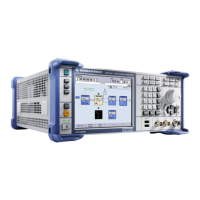Manual Operation
R&S
®
SMBV100A
78Operating Manual 1407.6062.32 ─ 08
Moving the cursor on the display
► To move the cursor, use one of the following alternative methods:
a) Use the rotary knob or the arrow keys.
b) Use the appropriate softkeys (CTRL+F1..F8) to move the cursor to the "Win-
bar".
If the "Winbar" is covered by a menu, press the WINBAR (CTRL+W) key to display
it in the foreground.
c) Use the ESC key.
Tip: Be aware that the function of the ESC key depends on the current cursor position.
The function of this key depends on the current cursor position.
● Calls the next higher selection level.
● Closes the open window without accepting new entries; the old value or param-
eter is retained.
● In dialog boxes that contain a "Cancel" button it activates that button.
● Closes all kinds of dialog boxes, if the edit mode is not active.
● Quits the edit mode, if the edit mode is active.
● Switches between different entry fields of a menu.
● Shifts the entry cursor from the header display to the previously active menu, or
to the previously highlighted block in the block diagram if no menu is active.
● Shifts the cursor from a function block in the diagram to the first item in the
"Winbar". If no menus are open, the current cursor position remains unchanged.
Moving the coursor to the heading area
► Press the FREQ (CTRL+F) or LEVEL (CTRL+L) key to move the cursor to the header
area.
4.4.2 Selecting a Control Element
Control elements are always selected in the same way no matter whether a function block
in the diagram, a menu in the menu tree, a parameter in the menu or an entry in a list or
table is concerned.
► To activate an element, put the cursor on it.
An active element is highlighted by a blue frame.
4.4.3 Switching Parameters On/Off
A parameter can be activated and deactivated using a button or a check box.
1. Select the parameter.
Setting Parameters

